We Got Lucky
The end of summer in 2020 was a perfect storm of dry weather, winds, and high temperatures. A great many fires started up across the west coast impacting many communities. - We live in Sandy, Oregon - we were a few miles north from two fires and if the wind had changed from westerly winds to northerly winds we very likely would have been caught up in this mess of fire, smoke, and more. We did mostly ok, and we can only be thankful for that. - Many of our neighbors did ok, but our local communities are in various stages of loss, damage, recovery, and healing. Our families thoughts go out to those affected.
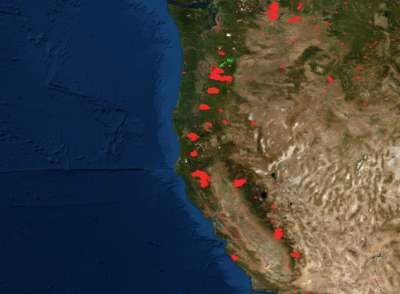
We need to take climate change seriously, and we need to start making changes to our lives. I started changing my life several years ago, but we need to make more progress, and more of us need to make progress. - Weather is getting more intense, and the environment is suffering. The more we do en-masse, the more impact we can have to make living on earth a more tenable thing.
Being Prepared
A little preparation is worth a lot more than reactions.
I have been asked a lot these past few days what I have to prepare for this kind of event, so I wanted to write a bit to share my perspective. There are lots of ways to be prepared for lots of things, but for this fire, the following things were used, and useful in more than a minor way. They were critical to safety, health, and comfort during the stressful event. These are what we used, but you may find something similar you like more, that’s awesome, this isn’t meant to be the perfect list or an exhaustive report. This will be a debrief about what I had on hand, and how well it worked in hindsight. I got asked so many times what I had on hand, and the answer is not much, but a few critical things did help. You don’t have to buy a bomb shelter to be ready for the next emergency situation, and a little preparation goes a long way to putting you in a position to help yourself and others, which should be the goal.
Better write ups about wildfire survival
- https://www.ready.gov/wildfires
- https://www.readyforwildfire.org/prepare-for-wildfire/
- https://www.redcross.org/get-help/how-to-prepare-for-emergencies/types-of-emergencies/wildfire.html
A Plan
I know life is busy, and modern life can leave us forgetting that we are still people surviving on a planet called Earth, but have a plan to cover the major emergencies that can come up. We can’t be prepared for it all, but there are some basics that will help. This all starts with thinking about what your options may be, not what you will do. In an emergency, its more important to have a series of useful options rather than a single plan you will commit to. Each option should be a series of actions, and information gained, that bring you to your next decision point.
We had the plan to stay and do what we can to manage our 20 acres of forest as long as it was safe to do so. We decided our safety margin was going to be the fire making it to Sandy proper to our south, which is on our valley’s opposing ridge a few miles off. This would mean we would head north to I84 via backroads and away from danger at that point to our next decision point. If Portland was too busy to the west from others evacuating, we would then head east to Hood River and stay with friends there. If I84 was looking busy, we would head east to highway 26 and proceed to Hood River and our next decision point. To ensure this was possible we were packed, and ready to leave with essentials only. We were also assessing the evacuation notices, weather, and watching information from fire management systems. No matter what anyone else said, we were still responsible for our own safety, which means applying some information gathering, critical thinking, and some decision making.
Information
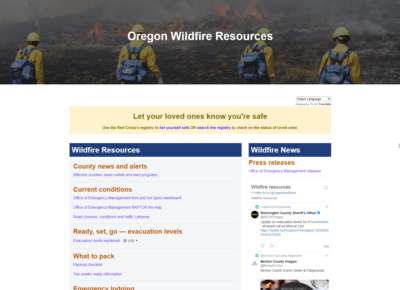
Know where to find institutional source of information, not your buddy on Facebook - for fires, your local government and firefighting organization should have good information. - Oregon put together this resource which was just perfect to consolidate all kinds of critical information pieces. There was a massive misinformation situation when Facebook groups shared incorrect information about how fires may have started, where they were, and what was going on. It eroded trust, and made it harder to work on real problems surrounding the fire. Bet smarter, be better, it’s our civic duty to use our critical thinking, don’t spread gossip, and don’t spread information we don’t have credible sources and reason to believe.
It’s normal for humans to react to stress by looking for stories and mythos that explain things, and that’s a good reaction to have, it can save your life, but it can also lead to unproductive gossip, and misinformation. Slow down, breath, think about the information as if you were a reporter, where did it come from, why would they know it, what does it inform, is it helpful to share, is it true? The Bureau of Land Management (BLM) is not in fact the same thing as Black Lives Matter (BLM) social rights movement. - Yet there are possibilities that those were conflated perhaps. - Point being, slow down, be critical about what information you share.
For fire related issues, there is also the NASA FIRMs system, which uses satellite data to identify spots of high energy, typically IR heat radiating from fires from satellite imagery. It’s very good, sometimes has a delay due to orbits - but this was how I could see what was happening around me when the smoke was so dense people, and aircraft couldn’t survey the fire line.
Mental Safety in Unsafe Situations
This is a complex topic that is worth many follow up posts, and many articles of sources, and discussion. - My point to include it, is that you must find ways that work for you (assistance is available through psychologists, therapy, and coaching) to cope with an emergency so that one can be mentally present, and have enough resilience to access, decide, and act to find safety, support, and to ultimately survive the emergency. This does NOT mean to ignore, bottle, or be without feelings, it means being able to keep your mind alert, and functional in the presence of feelings, stressors, and other things that are making it hard to function for long enough to get to safety. Do not discount this topic, do not let this be all that is said about this topic, and do not take for granted how your psychological safety, your moral, and your spirit will act as a force multiplier, for good or for bad. Even if someone didn’t have to evacuate from a fire, didn’t mean they didn’t get hit by the mental load of having to consider evacuating, and the worry for others who had to, and what they lost and suffered through. Everyone needs to take stock, and care of their psychological safety.
If you think you are ’too badass’ to think about your mental state, your mind, and your most powerful asset as a human, try this audio book, give it a listen, and go explore this broad topic. It’s worth it.
Can’t Hurt Me Master Your Mind and Defy the Odds By: David Goggins
Audible: Can’t Hurt Me: Master Your Mind and Defy the Odds By: David Goggins Goodreads: https://www.goodreads.com/book/show/41721428-can-t-hurt-me
Food
Gosh, what to say here, everyone likes different food, but generally I have some food on hand that requires no cooking, and isn’t perishable. Have some more food that can be eaten with no cooking but might be good in a fridge. Have more food that is easy to cook with simple things like a camping stove. Then have your normal food. Eat your food from most perishable to least, and eat more calories than normal because your will need them for mind and body.
We were surprised how helpful Soylent Mocha bottles were during this event. Good calories, nutrition, and no effort to cook/preserve. We ate drank many of these during the 5 days of heaviest impact, and still have them on the menu to help bridge the gap.
Water
REDCAMP 5.3 Gallon Portable Water Container with Spigot for Camping
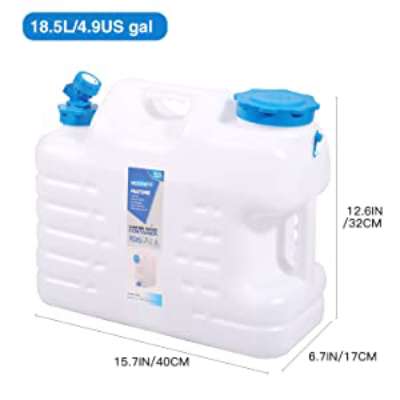
We have well water, but that requires power to run (see power section) - we stored water in containers, and put as many of them as we could fit into the fridge. When you put more thermal mass in the fridge, it takes longer to cool down due to the increased mass, and the opposite is true too, it will keep your fridge cooler longer as it takes longer to warm up. - This also doubled as sources of clean water for drinking and cleaning. Also fill your sinks, tubs, and any water holding elements of your home up - two fold, the water can be used for many purposes, but also if the fires get near, that will be one of the few sources of humidity left as things keep drying out.
I would suggest some kind of bulk water storage, everyone should have one, just refill it once a month, or add chorine to keep it safe.
Aside from drinking water, it is smart to water your yard, and make sure it isn’t completely dry. Do not just run your sprinklers indefinitely though - that will take water away from other users, such as fire fighters. Just make sure things are not completely bone dry. This strategy is more for fighting an ember than a full wildfire. Think of an ember landing miles away from the fire on your property/land/area - is it dry enough that a small ember would easily catch?
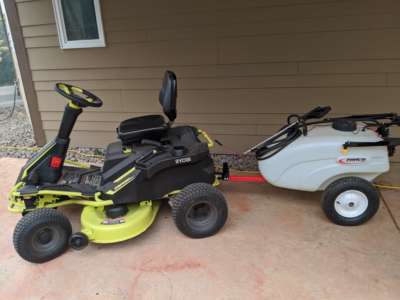
For ember watches over our property, what I had on hand was an electric lawn mower, with a 12v pump for spraying weeds which I filled up with 30 gallons of water. I removed the spray nozzle so instead of misting, it just shot a stream of water. I am able to bring this water as little as it is, to more places than I can a hose. I can not fight a large fire, but if I am the first person on scene, and I can stop an ember, or a small grass fire, that will help the larger cause. It’s important though, to get out of the way of firefighters - if they show up, get out of the way because they will have better equipment, tactics, and support than you will. There are much fancier models of such a thing, but having some way to bring water to a small fire is critical.
Medical
This is something there is no one answer for - I see many people buying expensive medical kits without all the knowledge to use those kits. Give this a look, consider these items, but before spending money on things, spend money on learning how to use those things. Medicine actually isn’t entirely as complicated as it might seem sometimes, but there are many ways that medical aid can become medical harm if done improperly. I keep a fully stocked IFAK kit for myself and my partner at home, and one portable one for trips. Our mission with our kits is to provide immediate care, and basic follow-up care to make time for medical professionals to make it to us, or us to them.
Check out these trainings:
- Community Emergency Response Teams (CERT)
- Wilderness First Responder
- Red Cross
- Stop The Bleed
- FEMA first aid courses
Clean Air Outdoors
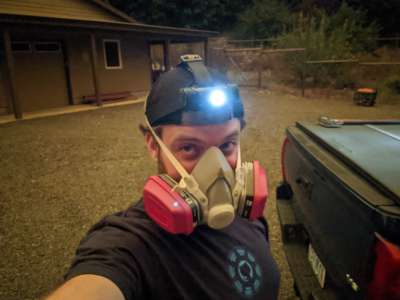
For going outside, have something to filter the air. Our lungs and respiratory system can filter air to various degrees, but it’s an expensive task that will take away from how productive we can be, and may need to be during an emergency situation. One time use masks are fine, but for a little more, these masks are a good investment and last a lot longer with proven results. They also are useful for a ton of various things in normal life where we are painting, or working with messy jobs. Definitely worth having this kind of thing on hand.
3M Multi Gas/Vapor Cartridge/Filter 60926, P100 Respiratory Protection
Clean Air Indoors
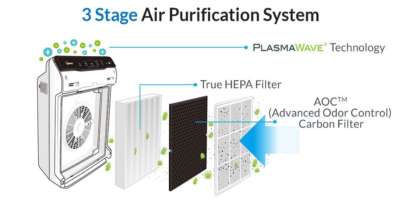
The Winix filters are very good, can really clean the air, and also emit a safe ozone that removes a lot of particulates from the air, like from a fire. A must have because even a sealed house will be flooded with smoke from the fires even with the windows closed. I also liked how it has a sensor that can automatically ramp up the motor speed when air pollution levels increase.
Use painters tape to seal any doors/windows fixtures in your house to help increase the air seal.
Winix 5500-2 Air Purifier with HEPA and PlasmaWave
Light
I decided to pick a single brand of ‘good’ lights that use a common long life rechargeable battery. I was happy with the performance and durability of the Nitecore equipment all based around the 18650 battery cell. Having a single battery makes it easier to manage during an event.
They have a good lineup - you can see it here: https://flashlight.nitecore.com/
Nitecore LR30 Magnetic Room Light
Power
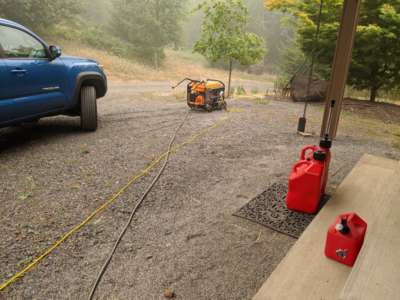
Having power is a big deal so we can keep phones running, have communications, charge lights, maintain fridges for food, and more. Much of these items I had for entirely different reasons than disaster prep, but I did have them on hand, and they worked well. In particular, the Orion battery bank with lithium that features a 120volt outlet was absolutely a valuable item for getting power into hard to get places. I even ran Winix filters off one in the bedroom when air quality was at it’s worse and we had no power there. I don’t think you have to get that exact model, but getting a lithium battery pack makes too much sense these days, and the prices are really not that bad. If I was buying again, I’d look at these: Goal Zero Portable Power The Generac mobile generator was something I had from years ago, and it worked well, but if I was doing this again, I’d get a Honda EU2200i entirely for the better fuel efficiency, cleaner AC power. If I needed more power, I’d get a second and use the parallel running kit, but I’d also consider two just so I could alternate loads from one to the other so the generators could have rest periods. The VP racing jugs were great to get many gallons at a time at home, with low risk of spilling, and the special spout makes it harder to overflow as it stops flow when full.
One last tip - I know some know this, but when you are running power off the grid - it’s important to make plans and schedule your power use. It’s very rare that you actually need power 24/7, it’s just convenient to have power 24/7. This could mean running the generator two or three times a day around meal times to charge batteries, cool down the fridge, and then ultimately turn it back off.
Orion Dynamo Pro 155Wh AC/DC/USB Lithium Power Supply
Generac XT8000E Portable Generator